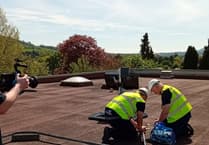Searches for ‘What do you need for a home gym?’ have seen a 500 per cent increase in the last 30 days, according to Google Trends data.
As people are focusing on healthy resolutions for the new year, the experts at Stokemont Party Wall Surveyors decided to collate some helpful tips for anyone looking to convert their spare space into a home gym.
Five useful tips for converting your spare space into a home gym, as explained by Cooper Mitchell from Garage Gym Reviews
1. Flooring
Put your flooring down before your equipment. Equipment is heavy, so you want to make sure you assemble your space first before bringing in your new equipment. There are many different flooring options available for home gyms, but for most, we suggest horse stall mats.
2. Proper storage
You’re working with finite space in a home gym. To maximize the area, we suggest storing as much equipment on the wall as possible. This means buying things like barbell gun racks, plate storage that is screwed into wooden studs, resistance bands and chain holders, etc.
3. Buy inexpensive equipment and research
Make sure to research what equipment you need and what is best for the goal you have. There are lots of articles online to read through and find the right equipment for you. You don’t need expensive equipment for your home gym. Check second-hand marketplaces for the best deals near you. Many people have built their gyms by scouring Facebook Marketplace, Craigslist or even Ebay. You can also try out different equipment and sell the items that don’t work for you, so you are never out of pocket.
4. Get a good sound system
This may seem like a minor detail, but it makes a big difference when it comes to exercising, it motivates you and gets you pumped to work out harder and better.
5. Invest in a mini fridge
Have a refrigerator in your gym so that cold protein shakes and drinks are always available – especially water! Mini fridges do not have to be expensive, and they are the perfect size to have placed in your home gym. Again, you could check second-hand marketplaces near you to find inexpensive deals on mini fridges.
Sam Moseley, owner at Grain and Frame, comments on creating a home gym: “Setting up a home gym in your extra space can be a great way to make the most out of your home while also staying fit. When it comes to interior design, here are a few things to keep in mind:
Pick the perfect spot: Choose a space that’s big enough for your equipment and has plenty of natural light.
Think up: Make use of vertical space with wall-mounted shelves or storage racks to save floor space.
Add some green: Bring in some plants or natural wood finishes to create a calm and relaxing environment during your workout.
Let the light in: Large windows or skylights can make the space more inviting and help to reduce the need for artificial lighting.”
Five things to consider when building a home gym outside, as explained by Bradley Mackenzie from Stokemont Party Wall Surveyors
1. Decide what you want
Creating space in your garden has become extremely popular, from sheds, to garages to the new, modern ‘Garden Rooms’. They are all structures that you can build in your garden and can be used for outdoor space, offices or a home gym! They give you extra space and are not expensive or difficult to install.
2. Permissions
The construction of the new gym room/structure would need to comply with permitted development or planning permissions. The structure would also need to be building regulations compliant. Most installers of garden offices/studios will complete these tasks, however some don’t, so it’s worth checking. This can add delay and cost to the install.
3. The Party Wall Act 1996
When creating a new structure, you must take notice of the Party Wall Act 1966. If any new sheds, gym spaces or structures are within six meters of any neighboring structures – Party Wall Notices will need to be served. This will also occur if the walls of the new structures are built up to the neighboring boundary lines.
4. Insulating
Garden structures can get cold in the winter, due to their outdoor setting, so if you intend to have a warm gym – storage heaters and electric radiators can be used. However, it is important to keep these on a low setting so as not to result in expensive electricity bills.
5. Height
Finally, it is important to note the height of your gym equipment.
An average treadmill is anywhere from nine inches upwards from floor level; this can be expected to increase after an incline setting change, so ensure your ceiling is high enough to accommodate your equipment.
*For more information and advice visit https://stokemont.com/party-wall-surveyors/





Comments
This article has no comments yet. Be the first to leave a comment.